


Into the Fryer…
Danny Meyer has a saying (well, he has many of them): “The road to success is paved with mistakes well handled.” And though he didn’t coin that one about Shake Shack’s adventures with fresh cut fries, he might as well have. As Randy recalls it, “We first chose the crinkle cut fry because it was classic, reminiscent of childhood. And because we had no space. Of course we had to do a frozen fry, because we were in some goofy little kiosk.” There were grumbles, but it wasn’t until February 2012, when New York Times restaurant critic Pete Wells famously asked why Shake Shack couldn’t make a decent French fry, that Randy and Mark Rosati launched a soul-searching journey. They were convinced that fresh cut fries were the answer.
“My job was to get fresh fries into all the Shacks. We started with something that wouldn’t necessarily work and basically what we did was to get it to not necessarily work everywhere.”
—ZACH KOFF, CHIEF OPERATING OFFICER

@the_m_o_m
“Mr. Meyer runs one of the world’s great restaurant companies. Can’t one of his chefs show him how to make a decent French fry?”
— PETE WELLS, RESTAURANT CRITIC
THE NEW YORK TIMES, 2/22/12
Mark: To make the switch to fresh cut fries, Jeff Amoscato and I flew around the country looking at potato farms, meeting farmers, testing: Back in New York, culinary manager Gillian Ortiz and I would fry fresh potatoes and get perfect batches—golden brown and crunchy and crisp. The next day, they’d be over-caramelized, burnt, and soggy. We couldn’t figure out what was going wrong. Once we found a farm that would be crazy enough to actually check the sugar content of potatoes before they sent them to us, we thought we had it. Then we discovered the rail car wasn’t heated. So it’d be going through the Midwest in the winter, the train would stop, all that cold air would get to the potatoes and make the sugar level spike. We’d get to the Shack, cook the fries, and again: dark brown.
Randy: We found the path of the potato could not be controlled. In reality, we discovered that the fresh fry cannot be made right every day, every time. Mark was doing all kinds of different crazy things. Vinegar, marinating—thrice fried…
Mark: Thrice fried came out of spending time in London and tasting Heston Blumenthal’s fries (he’s the 3-star Michelin chef of The Fat Duck). His were the best fries I’d ever had. The more research I did, it turned out his process was not unlike what a big fry manufacturer would do: water blanching to start to cook the potato and set the starches, give it that nice crispiness on the outside, and then freeze it. Heston loved freezing potatoes so the ice crystals would explode, creating a mashed potato–like inside.
Randy: Refrigerating, not refrigerating. Name your favorite thing, we tried it. And Mark and Gillian perfected it: twice fried, soaked until the starch ran out, and washed until the water ran clear.
Mark: The real magic was in developing a process the Shacks could actually execute. We had these giant bins made with casters, so we could cut potatoes into them, fill them with water, then roll them into the walk-in. We had to pull them out and drain the water. Such a nightmare.
Randy: We spent over $1 million on this experiment. And that’s just equipment. I’m not talking about the emotional pain.
Mark: Oh, no price on that.
Randy: For the famous launch day, we made T-shirts that said, “Heard” and I actually delivered a note to Pete Wells (a year and a half after his review) with a T-shirt, “Pete, Heard.” Everyone in the Shack wore them. On day one, I served fries at the Upper East Side Shack, but I might as well have been going twelve rounds with Mike Tyson. I’ll never forget the woman who said, “You have ruined my life with these fries. I will never be back.”
Mark: The best was the very first guest at the Upper East Side, day one. I was with our team on the front line, ready to cook the first order of fries. Big smiles on our faces. Guy walks in and orders the fries. We’re all watching to see his reaction. He goes nuts: “What the hell is this? These aren’t your fries! You guys are becoming too big and too corporate. I want my money back!” And we’re thinking how un-corporate and crazy this really was.

We were sure we were doing the right thing by converting to fresh cut fries.
Randy: Over the course of a year, we converted the whole company to fresh cut fries. And the divided camps began. It was “They’re so great,” or, “What are you thinking? These are terrible.” Meanwhile, in the Shacks, our best people on the front lines were relentlessly under fire from angry customers. The potato cutting devices were falling off the wall. Because once you cut 2,000 potatoes (and that’s just in one day)…
Mark: We were literally ripping them out of the wall.
Randy: So now, we can’t cut potatoes; water’s spilling everywhere; people were getting injured. Everything bad was happening, and our response was “No, no, no, people. We know better.” We were unyielding while our guys were taking the heat. Then we began to doubt ourselves. But no one would admit it, because my leadership style is to keep going forward. I’m a pretty good listener, but nobody’s going to tell me we made a bad million-dollar decision here. And Danny? He was with us at the outset, so he wasn’t about to admit that he was bummed out, too.
Meanwhile, I’m doing taste tests with my kids and they tell me they like crinkle cuts better. So two things happened, in the same weekend. An Instagram post appears from Jessica Seinfeld, Jerry’s wife, who’s a talented cookbook author. They’d ordered burgers to their Little League game in Central Park. Her post said, “Thank you, Shake Shack, we love you, but PS, can we talk about these fries at some point?” And some guy responds to her saying, “Yeah, can you just tell Danny Meyer we don’t care about fresh fries, we just want ’em to taste good?” And, at that moment, I remember thinking, “What are we doing here?”
That same weekend, I ordered burgers for my kids’ last Little League game. And I chose not to order fries. I, myself, don’t order them because I know deep down the kids don’t want ’em. At the end of that weekend, I called Danny and said, “I think we screwed this up.” And it felt like an existential moment, like someone who’s finally come clean about something they’ve always wanted to come clean about.
Mark: As soon as we heard this, we all said “Thank God.”
Randy: So in mid-2014, we decided to go back to crinkle cuts. Then I challenged the team: How can we go back better? How can we stand for something good here? And the beauty of the timing was in that whole last year of this process, in London, we had launched a crinkle cut fry that had none of the preservatives or coloring of the original Shack fry. So we took that learning, applied it here, and relaunched.

At the time, this was our most-liked Instagram ever, when we announced the return of crinkle cuts.
Mark: The food requirements in London meant we were already making those fries. But we could not import them. Our fry company has a big plant in the U.K. So we reached out to them and asked, “Could you possibly give us a better frozen fry as an alternative in the U.S.?”
Randy: One of the other lessons here is that it’s important to say that we allowed a few loud voices to lead us to believe there really was this groundswell of people who didn’t like the crinkle cuts. That’s where we were just wrong. Were there voices? Of course there were. They were loud. And I didn’t listen to my people who were good soldiers and followed me, even when it all started to go wrong. What we learned is that we had ten years of people who loved crinkle cut fries. So shame on us for over-intellectualizing the whole thing.
“We do things that others are unwilling or unable to do.”
—RANDY GARUTTI

Our Yukon potatoes.
LOCAL HERO

COLUMBIA RIVER BASIN, WA
Our potatoes for fries have had a nice life, grown as they are on farms in Washington State along the Columbia River Basin. Lamb Weston, as described by Dave Smith, manager of long-term innovation, is a company that “has their hands in the dirt, with a world view of sustainability, mindful of water resources. We know our land has to be productive forever: we can’t ruin it!” Lamb Weston’s 100 Circle Farms form those vast, sweeping crop circles you’ve looked down on from airplane windows. It’s said they’re even visible from space! Potatoes are grown along with herds of dairy cattle, who then feed on the harvested potato plants, making a virtuous circle. The potatoes we use are large and yellow or gold fleshed.
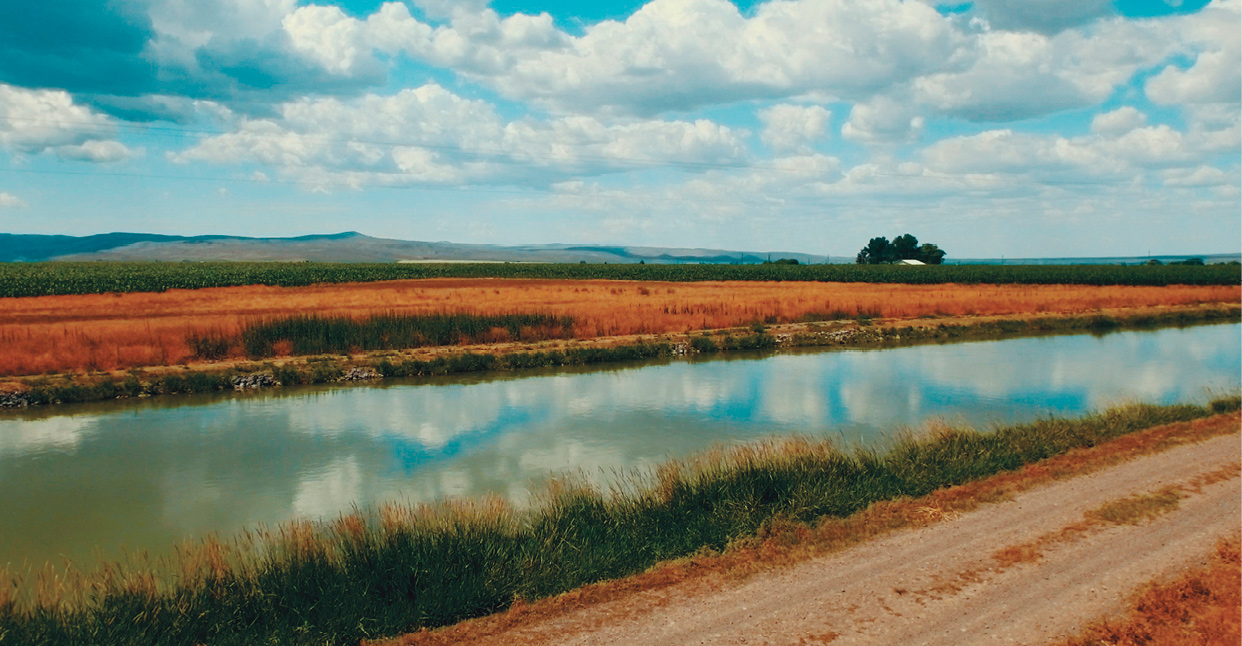
Low Line Canal in Idaho’s Magic Valley, another rich potato-growing region.

Harvest at Lamb Weston 100 Circle Farms, in Washington’s Columbia River basin. Freshly dug potatoes go from field to truck to the plant to be washed, cut, and made into French fries in a few hours.

Potato fields in bloom in Idaho’s Snake River Valley.
Anatomy of Crinkle Cut Fries

 CANOLA OIL There’s no such thing as a canola (the can comes from Canada, and ola means “oil”). The oil is pressed from a plant called rapeseed. Its neutral flavor and high smoke point make it good for frying.
CANOLA OIL There’s no such thing as a canola (the can comes from Canada, and ola means “oil”). The oil is pressed from a plant called rapeseed. Its neutral flavor and high smoke point make it good for frying.
 YELLOW POTATOES Which potato is best for frying? We learned the hard way so you do not have to. Just use the biggest yellow-fleshed potatoes you can find. Their sweetness is its own reward.
YELLOW POTATOES Which potato is best for frying? We learned the hard way so you do not have to. Just use the biggest yellow-fleshed potatoes you can find. Their sweetness is its own reward.
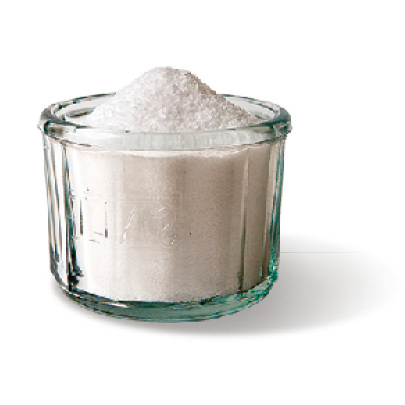 KOSHER SALT What makes fries fries are the minute crystals that deliver a salty crunch on the way to the potato’s soft interior. Kosher salt is so sprinkly, it fairly dances on the surface of a just-cooked fry.
KOSHER SALT What makes fries fries are the minute crystals that deliver a salty crunch on the way to the potato’s soft interior. Kosher salt is so sprinkly, it fairly dances on the surface of a just-cooked fry.
 CRINKLE CUTTER Yes you can cut your potatoes like a pro. We tried lots of cutters, but this U-shaped wonder was the easiest to use and sturdy enough for those big Yukons.
CRINKLE CUTTER Yes you can cut your potatoes like a pro. We tried lots of cutters, but this U-shaped wonder was the easiest to use and sturdy enough for those big Yukons.
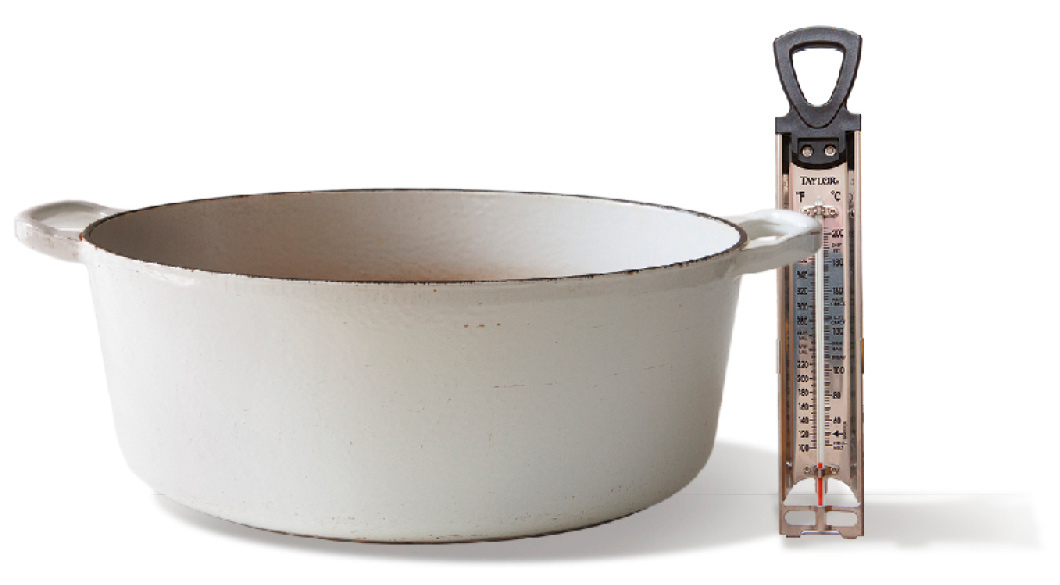

Let’s admit it: Our fries are always better at a Shack! But we did experiment with making crispy fries at home so you didn’t have to! Thinking like restaurant cooks, our experience making excellent fries with heavy-duty deep-fat fryers naturally led us to investigate the electric home version. And though the machine is nifty, we were delighted (and relieved) when a heavy, deep pot and a good (readable) candy thermometer proved easier to use (and store) and delivered great results.

Making Crinkle Cut Fries
It’s easier than you think to make crispy French fries in your kitchen.
1. Peel potatoes, and submerge in a bowl of cold water to keep them from turning brown.

2. With the crinkle cutter, cut the potato lengthwise into ½-inch slices.
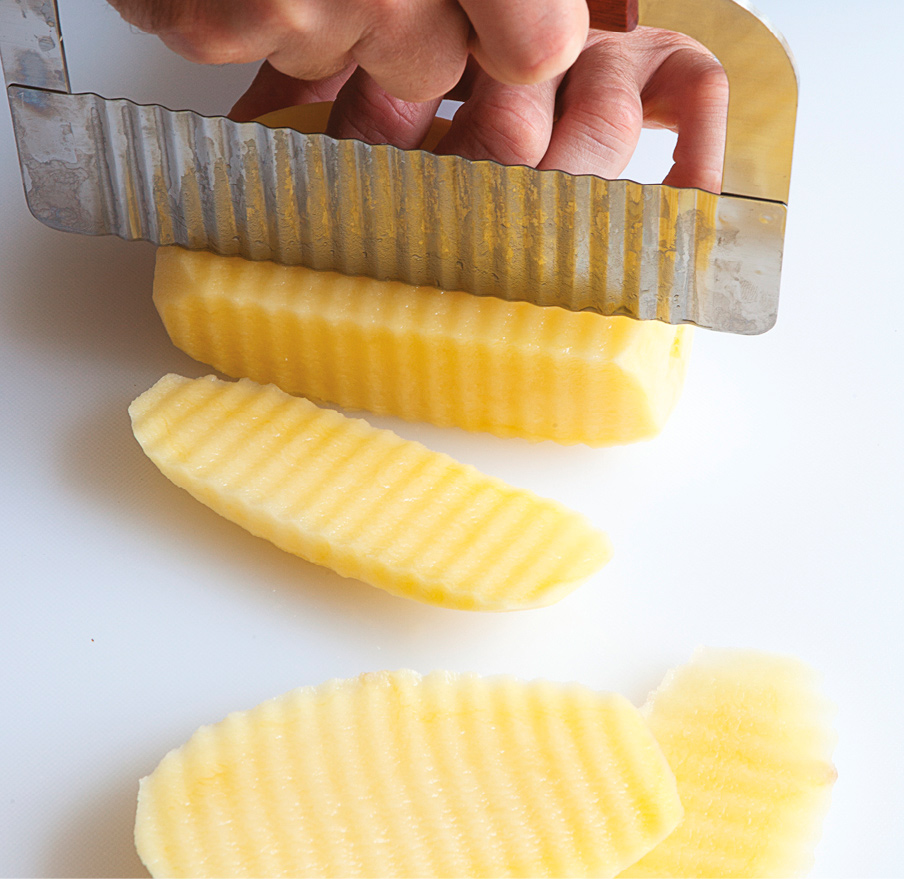
3. Cut each potato slice lengthwise into ½-inch-thick fries.
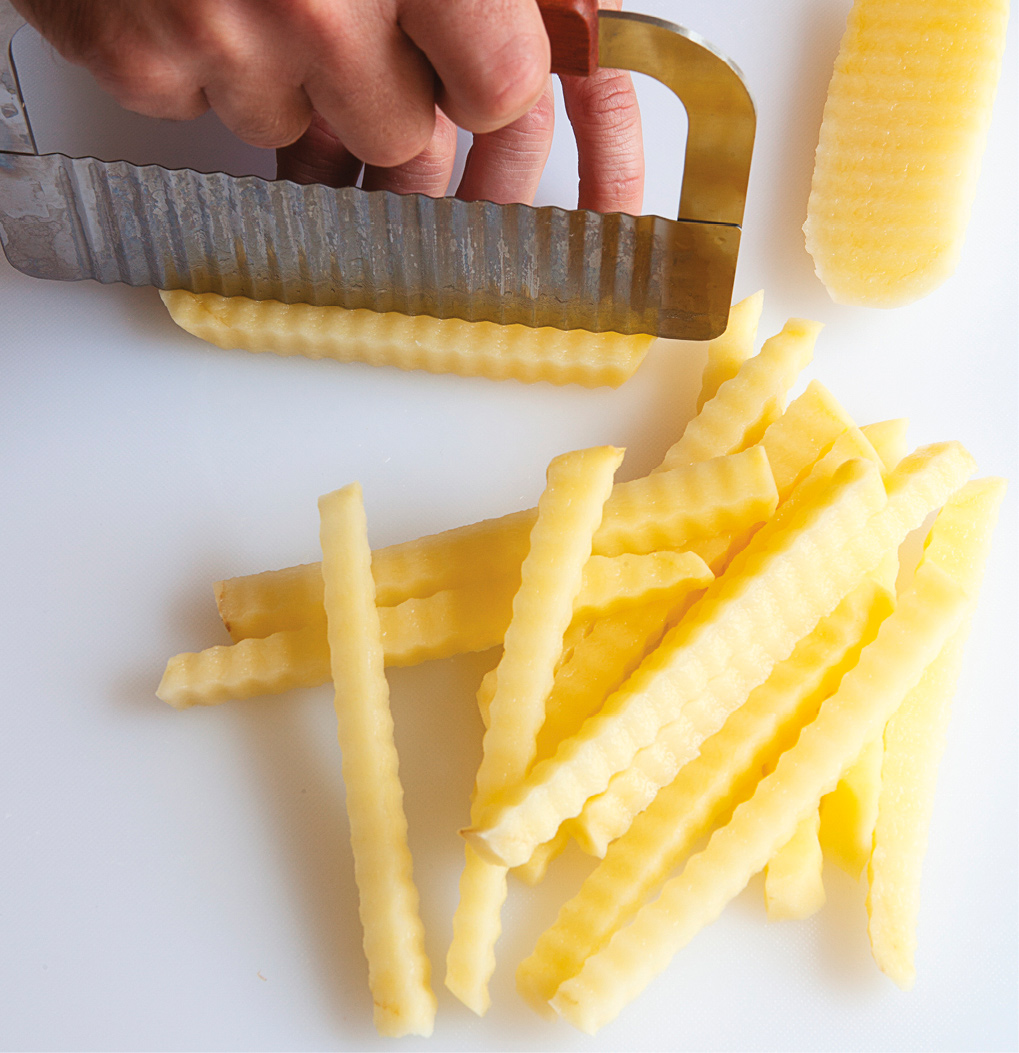
4. Rinse the fries in cold water, then simmer over medium heat until just tender.

5. Transfer the boiled fries to a wire rack to drain and cool. Pat with paper towels.

6. Pour canola oil into a heavy, deep pot and heat until 350°F. Working in batches, fry until potatoes are pale gold and tender, 10 to 12 minutes. Drain.

7. Spread the fries on a baking pan and freeze to wick remaining moisture. At this point, they can be frozen in a plastic bag for future frying.
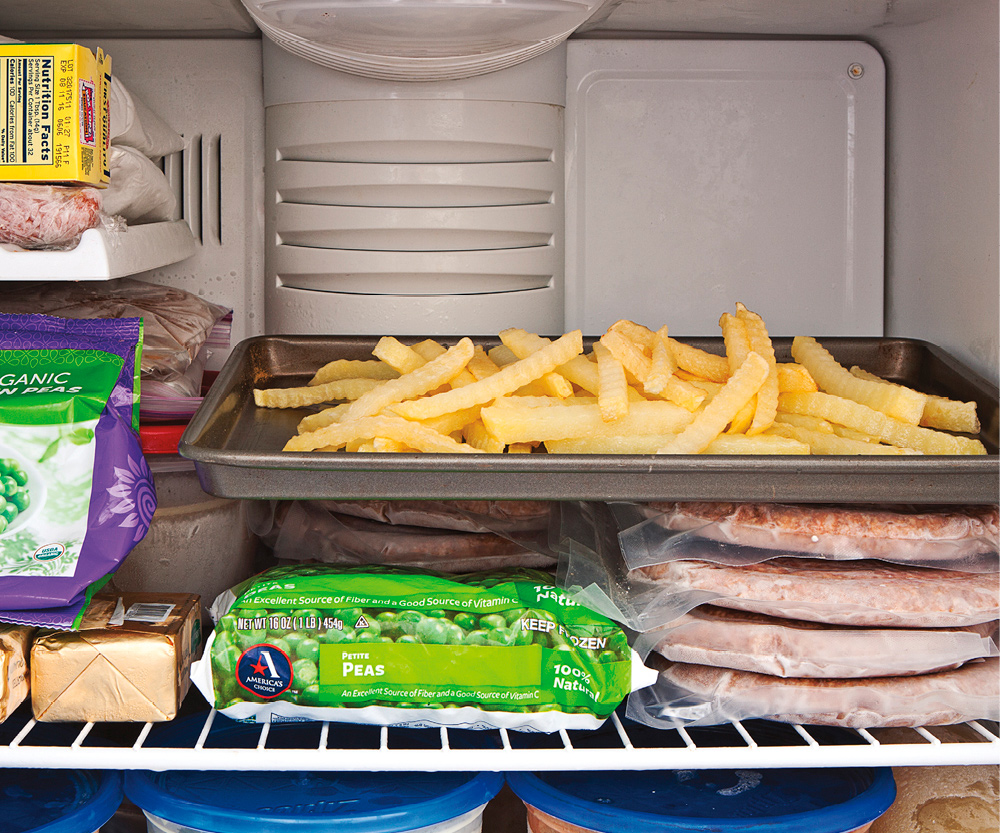
8. Fry in batches in canola oil at 350°F until deep golden brown and crisp. Drain and salt.


@epitomeatl

SERVES 4
There are many easy steps to transform Yukon potatoes into their friable state. It’s all spelled out on this page. When you’re ready to fry your crinkle cuts, here’s a simple way to do it. We like to fry our potatoes in two batches to maintain the temperature of the oil.
Canola oil for deep-frying
1pound frozen crinkle cut fries
Kosher salt
1. Pour the oil into a heavy, deep pot to a depth of 4 inches. Heat over medium-high heat until the temperature of the oil reaches 350°F on a candy thermometer.
2. Use a wire spider or slotted spoon to carefully lower the frozen fries into the hot oil. Deep-fry until they’re deep golden brown and crisp, 2 to 3 minutes. Transfer the fries to paper towels to drain. Salt and serve immediately.


SERVES 4
We wouldn’t swear that folks eat fries this way in Ireland, but we created Irish Fries as a way to celebrate St. Patrick’s Day—and called them When Irish Fries Are Smiling. (Sorry.) The Horseradish Cream is a versatile condiment. Try it on a burger!
Pile 1 recipe of hot Crinkle Cut Fries on a platter and spoon the Horseradish Cream over the fries. Scatter 6 slices cooked, diced bacon and ½ cup thinly sliced scallion greens on top of the fries. Serve immediately.

MAKES ABOUT ¾ CUP
Put ½ cup crème fraîche, ¼ cup well drained prepared horseradish, and 2 teaspoons fresh lemon juice into a mixing bowl and stir until well combined. Season with salt and pepper.


SERVES 4
Cheese sauce on fries has been a classic from the beginning of time. Once again, we’re not giving away our secrets, but we developed this version so you can happily make it at home with available ingredients. Use it on burgers, and hot dogs, and vegetables, too.
Heap hot Crinkle Cut Fries on four plates. Spoon about ¼ cup of warm cheese sauce over the fries and serve immediately.

MAKES ABOUT 6 CUPS
1tablespoon canola oil
½onion, peeled and sliced ½ inch thick
6thin slices jalapeño
2teaspoons whole black peppercorns
½teaspoon kosher salt
1tablespoon white wine vinegar
2teaspoons white wine
2cups heavy cream
2cups grated American cheese
2cups grated cheddar
1. Heat the oil in a large saucepan over medium heat. Add the onions, jalapeños, peppercorns, and salt, and cook, stirring often, until the onions are translucent, about 5 minutes. Add the vinegar and wine, and cook until the liquid has almost completely evaporated, about 5 minutes. Stir in the cream. Remove the pan from the heat and let the cream steep for 30 minutes to build flavor.
2. Return the saucepan to the stove and heat over medium heat until very warm (don’t let it come to a boil).
3. Meanwhile, put the American and cheddar cheeses into a large heatproof bowl. Pour the hot cream through a strainer (to remove the solids) over the cheeses, stirring until the cheese melts and the sauce is smooth, about 3 minutes. Sauce will keep, covered and refrigerated, for up to 1 week. You can easily reheat the sauce in a microwave or over a pot of gently simmering hot water.

• Fries with Belgian Ale. When I was a kid, milk was said to be the perfect food, but for me, it was always French fries! Since fries are more Belgian than French, it’s no coincidence that Belgian pale ales are perfect with fries. Ale’s caramel maltiness enhances the fries’ golden crust; its brisk carbonation emphasizes the potatoes’ fluffiness.
—Garrett Oliver, Brooklyn Brewery

• Crinkle Cuts & Petit Sirah. “Can I share your fries?” is a phrase etched into the fear-center of any married man’s brain. It means that your wife is about to eat 51% of the fries that were barely enough to satisfy you! I’ve discovered that if I smother mine in cheese I can knock that percentage down to 33. I’ve also discovered that fries in cheese sauce pair beautifully with Petit Sirah. The wine’s rich texture and brooding fruitiness match the salty crispiness of the fries and all that cheesy goodness. Oh, and, expect 33% of your wine to be “shared” too …so order a second glass from the C-Line.
—Jonah Beer, Frog’s Leap


SERVES 4
This is a really unexpected regional recipe. Putting curry spices in a chili recipe is a culinary quirk of the Providence region that Mark grew to love. Heaped on top of fries (or dogs, or burgers, for that matter) this sauce quickly becomes the star.
Heap hot Crinkle Cut Fries on four plates. Top with warm Chili Sauce and serve immediately.

MAKES 3 CUPS
¼cup canola oil
1onion, peeled and finely diced
2tablespoons ancho chili powder
2tablespoons smoked paprika
1½teaspoons mustard powder
¼teaspoon curry powder
¼teaspoon ground allspice
¼teaspoon ground cinnamon
⅛teaspoon ground star anise
1pound freshly ground beef
1cup beef stock
1teaspoon vinegar
Salt
Heat a medium skillet over medium heat. Add oil and onions and sauté, stirring often, until translucent, about 5 minutes. Stir in ancho chili powder, paprika, mustard powder, curry, allspice, cinnamon, and star anise, and cook until fragrant, about 2 minutes. Add ground beef and cook, breaking it up with a spoon, until it’s just browned, about 5 minutes. Add stock and simmer over medium-low heat for 30 minutes. Add vinegar and season with salt.




SERVES 4
Hawksmoor is a wonderful modern steakhouse whose chef Richard Turner and owner Will Beckett were so welcoming to us when we first opened in London. We were inspired by their bone marrow gravy to create our own version. This recipe makes enough sauce to spoon on a nice dry-aged steak like they do at Hawksmoor.
Divide 1 recipe hot Crinkle Cut Fries among four plates. Spoon about ¼ cup warm Bone Marrow Gravy over the fries and serve immediately.

MAKES ABOUT 4½ CUPS
5tablespoons unsalted butter, diced
5tablespoons flour
2¼cups beef stock
Salt and freshly ground black pepper
4tablespoons diced bone marrow, removed from bones
2½teaspoons sherry vinegar
1. Melt the butter in a medium saucepan over medium-low heat until just melted. Whisk in the flour and cook, whisking constantly, until the flour mixture begins to turn golden brown and has a nutty aroma, about 3 minutes. You may need to use rubber spatula to scrape the flour mixture out of the corners of the pan.
2. Whisk in the stock until smooth. Add a pinch of salt and pepper. Increase the heat to medium-high and bring to a boil. Reduce the heat to medium and whisk in the marrow, which will melt into the sauce. Simmer the gravy, stirring often, about 3 minutes.
3. Remove the pan from the heat and whisk in the vinegar. Strain the gravy through a sieve into a clean saucepan. Keep warm over lowest heat.

@benononsense

SERVES 4
We may have gone through our particular hell experimenting with fresh cut fries at the Shacks, but that doesn’t mean you can’t make great ones at home. We’re happy to share our hard-won expertise. Here’s how. Fry them twice in small batches. Wait at least 15 minutes and up to 4 hours before frying them again. They’re ready for the second fry when the outside of the potatoes looks glazed and shiny.
4large Yukon potatoes
Canola oil for deep-frying
Kosher salt
1. Use a large, sharp knife to carefully cut each potato lengthwise into ¼-inch-thick slices. Then cut the potato slices lengthwise into ¼-inch-thick sticks. Submerge them in a large bowl of cold water to keep them from turning brown.
2. Rinse the starch from the potatoes under cold running water, drain them, and dry well with paper towels.
3. Pour the oil into a heavy, deep pot to a depth of 4 inches. Heat over medium heat until the temperature of the oil reaches 320°F on a candy thermometer.
4. Use a wire spider or slotted spoon to carefully lower the fries into the hot oil. Deep-fry the potatoes until they develop a pale golden skin and are tender when pressed between your thumb and forefinger, about 2 minutes. Transfer the fries to a wire rack to drain and cool for at least 15 minutes (and up to 4 hours). Remove the pot of oil from the heat.
5. Reheat the pot of oil over medium-high heat until the temperature reaches 375°F on a candy thermometer. Working in batches, use a spider or slotted spoon to carefully lower the fries into the hot oil. Deep-fry until they are golden brown and crisp, about 1½ minutes. Transfer the fries to paper towels to drain. Salt and serve immediately.



SERVES 4
Fried pickles are a Southern specialty that we developed at the same time as we figured out our fried chicken. They’re so fun to eat. Serve them with a variety of toppings, such as ShackSauce. Or even ketchup!
2cups round kosher dill pickle slices, drained
1½cups buttermilk
2cups flour
½teaspoon freshly ground black pepper
Canola oil for deep-frying
Kosher salt
1. Soak the pickles in the buttermilk for 5 minutes a large bowl. Whisk together the flour and pepper in a deep wide dish. Set the pickles and seasoned flour aside.
2. Meanwhile, pour the oil into a heavy, deep pot to a depth of 3 inches. Heat over medium heat until the temperature of the oil reaches 350°F on a candy thermometer.
3. Working in batches, dredge the pickles in the flour, shaking off any excess flour. Use a wire spider or a slotted spoon to carefully lower the pickles into the hot oil. Deep-fry the pickles, turning them halfway through, until they are golden brown and crisp, about 3 minutes. Drain on paper towels. Salt and serve immediately.